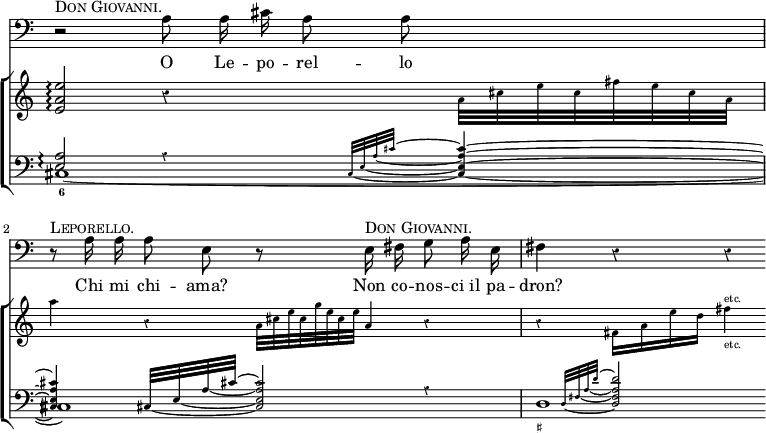being filled in on the Harpsichord, Pianoforte, or Organ. As a general rule, these Harmonies were very simply expressed: but, when relief was needed, considerable licence was permitted to the Accompanyist. Such a passage as the following might therefore have been accompanied, without any excess of liberty, by the passages indicated in small notes, provided they were sparingly introduced, played lightly, and not brought too prominently forward.

When the Harpsichord and the Pianoforte were banished from the Opera Orchestra, the Accompaniment of Recitativo secco was confided to the principal Violoncello and Double Bass; the former filling in the Harmonies in light Arpeggios, while the latter confined itself to the simple notes of the Basso continuo. In this way, the Recitatives were performed, at Her Majesty's Theatre, for more than half a century, by Lindley and Dragonetti, who always played at the same desk, and accompanied with a perfection attained by no other Artists in the world, though Charles Jane Ashley was considered only second to Lindley in expression and judgment. The general style of their Accompaniment was exceedingly simple, consisting only of plain Chords, played arpeggiando; but occasionally the two old friends would launch out into passages as elaborate as those shown in the following example; Dragonetti playing the large notes, and Lindley the small ones.
![<< \override Score.BarNumber #'break-visibility = #'#(#f #f #f) \override Score.Rest #'style = #'classical \override Score.TimeSignature #'stencil = ##f \time 4/4
\new Staff { \clef bass \relative c { \autoBeamOff
r4 r8^\markup \caps "Don Giovanni." c16 c f8 f16 f f8 g16 a |
g8 g r16 g^\markup \caps "Leporello" g g g8 d r d16^\markup \caps "Don Giovanni" d |
g8 g r a a f r4 } }
\addlyrics { Per la ma -- no essa allo -- ra me pren -- de An -- co -- ra meg -- lio M' -- acca -- rez -- za, mi_abra -- cci -- a }
\new Staff << \clef bass
\new Voice \relative f, { \teeny
<f c' a'>4\arpeggio s2. |
f'8\rest f16\rest \afterGrace b,!( { d f g f } \grace b8)
f8\rest f16\rest d( f g b g d'8) r |
f,8\rest f16\rest g([ b d)] f8 f,8*3/2\rest
a'4*1/8^> f8*1/4[ d b g] f[ d b d] g,4*1/8 | }
\new Voice \relative f { f1 | b, _~ b } >>
\figures { s1 <6 4> } >>](http://upload.wikimedia.org/score/3/2/32h3lo201ngpfoh6utdl6k5qlayoppq/32h3lo20.png)
In no country has this peculiar style been so successfully cultivated as in England; where the traditions of its best period are not yet forgotten. Attempts have lately been made to supersede it, by filling in the Harmonies on the Pianoforte, or arranging them for the Band.
[ W. S. R. ]
SECHTER, Simon. One of the most important of the modern contrapuntists. Born at Friedberg, in Bohemia, on Oct. 11, 1788. In 1804, after a moderate musical education, he went to Vienna, where he applied himself with ardour to theoretical studies. In 1809, while Vienna was in the hands of the French, he made the acquaintance of Dragonetti—then living in concealment under the curious apprehension that Napoleon would oblige him to go to Paris—for whom he wrote the pianoforte accompaniments to his concertos for the double bass. In 1810 Sechter became teacher of the piano and singing to the Blind Institute, for which he wrote many songs and two masses. During the whole of this time he pushed forward his studies, working more especially at Bach and Mozart. He found a good friend in Abbé Stadler, through whose means three of Sechter's masses were performed at the court chapel. A requiem of his, and a chorus from Schiller's 'Bride of Messina' were also executed in the Concert Spirituel with success. In 1824 he became Court-organist, first as subordinate, and in 1825, on the death of Worzischeck, as chief, an office which he retained till his death. His fame as a theoretical teacher attracted numerous scholars, amongst others the great Schubert, who was on the point of taking lessons from him, when attacked by his last illness [App. p.792 "[See vol. iii. p. 353a.]."]. The Emperor Ferdinand conferred upon him the large gold medal for a grand mass dedicated to his majesty, which was shortly followed by the order of St. Louis from the Duke of Lucca. In 1850 he became Professor of Composition in the Conservatorium at Vienna. His Aphorisms, etc., which he communicated to the Vienna Allg. musik. Zeitung, show him to have been a profound thinker, and give many instructive hints both to teachers and scholars. His most intimate friends were Staudigl, Lutz, and Holzel, for whom he wrote a quantity of humorous Volkslieder
